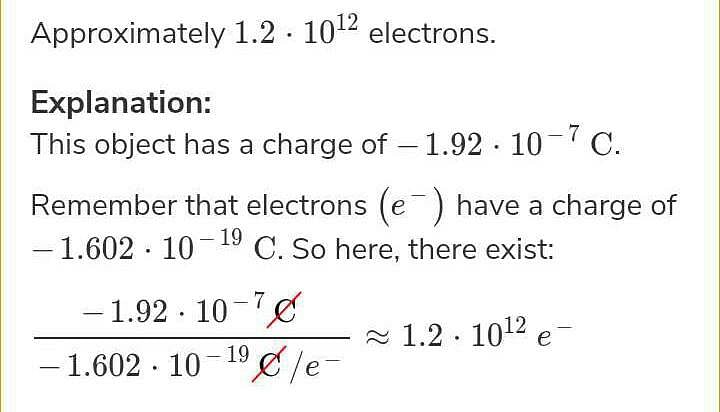Class 12 Exam > Class 12 Questions > An object has as excess charge of -1. 92× 10 ...
Start Learning for Free
An object has as excess charge of -1. 92× 10 -17 C. How many excess electrons does it have?
Most Upvoted Answer
An object has as excess charge of -1. 92× 10 -17 C. How many excess el...
Calculating Excess Electrons
To calculate the number of excess electrons an object has, we need to use the fundamental charge of an electron, which is -1.602 x 10^-19 C.
Formula
The formula to calculate excess electrons is:
Excess electrons = Excess charge / Fundamental charge of an electron
Calculation
Given that the object has an excess charge of -1.92 x 10^-17 C, we can calculate the number of excess electrons using the formula above:
Excess electrons = -1.92 x 10^-17 C / -1.602 x 10^-19 C
Excess electrons = 120 electrons
Therefore, the object has 120 excess electrons.
Explanation
When an object gains or loses electrons, it becomes charged. The charge of an object can be positive or negative, depending on whether it has gained or lost electrons. The charge is measured in Coulombs (C), which is a unit of electric charge.
In this case, the object has an excess charge of -1.92 x 10^-17 C, which means it has gained electrons. To calculate the number of excess electrons, we need to divide the excess charge by the fundamental charge of an electron, which represents the charge of a single electron. The result gives us the number of excess electrons that the object has.
In summary, to calculate the number of excess electrons an object has, we need to use the formula Excess electrons = Excess charge / Fundamental charge of an electron. This formula helps us understand the charge of an object and the number of excess electrons it possesses.
Community Answer
An object has as excess charge of -1. 92× 10 -17 C. How many excess el...


|
Explore Courses for Class 12 exam
|

|
Similar Class 12 Doubts
An object has as excess charge of -1. 92× 10 -17 C. How many excess electrons does it have?
Question Description
An object has as excess charge of -1. 92× 10 -17 C. How many excess electrons does it have? for Class 12 2024 is part of Class 12 preparation. The Question and answers have been prepared according to the Class 12 exam syllabus. Information about An object has as excess charge of -1. 92× 10 -17 C. How many excess electrons does it have? covers all topics & solutions for Class 12 2024 Exam. Find important definitions, questions, meanings, examples, exercises and tests below for An object has as excess charge of -1. 92× 10 -17 C. How many excess electrons does it have?.
An object has as excess charge of -1. 92× 10 -17 C. How many excess electrons does it have? for Class 12 2024 is part of Class 12 preparation. The Question and answers have been prepared according to the Class 12 exam syllabus. Information about An object has as excess charge of -1. 92× 10 -17 C. How many excess electrons does it have? covers all topics & solutions for Class 12 2024 Exam. Find important definitions, questions, meanings, examples, exercises and tests below for An object has as excess charge of -1. 92× 10 -17 C. How many excess electrons does it have?.
Solutions for An object has as excess charge of -1. 92× 10 -17 C. How many excess electrons does it have? in English & in Hindi are available as part of our courses for Class 12.
Download more important topics, notes, lectures and mock test series for Class 12 Exam by signing up for free.
Here you can find the meaning of An object has as excess charge of -1. 92× 10 -17 C. How many excess electrons does it have? defined & explained in the simplest way possible. Besides giving the explanation of
An object has as excess charge of -1. 92× 10 -17 C. How many excess electrons does it have?, a detailed solution for An object has as excess charge of -1. 92× 10 -17 C. How many excess electrons does it have? has been provided alongside types of An object has as excess charge of -1. 92× 10 -17 C. How many excess electrons does it have? theory, EduRev gives you an
ample number of questions to practice An object has as excess charge of -1. 92× 10 -17 C. How many excess electrons does it have? tests, examples and also practice Class 12 tests.

|
Explore Courses for Class 12 exam
|

|
Signup for Free!
Signup to see your scores go up within 7 days! Learn & Practice with 1000+ FREE Notes, Videos & Tests.



















